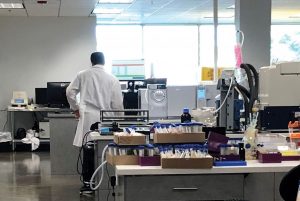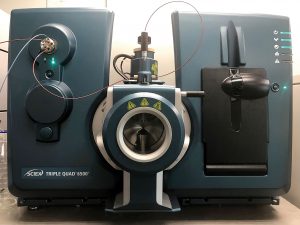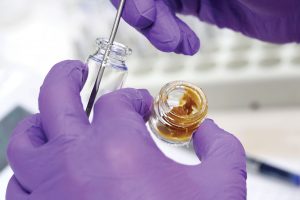In the United States, medical cannabis has been gaining legal status state by state, starting in California, where a ballot initiative called the Compassionate Use Act was passed in 1996. In the 22 years since, 32 more states have made the jump, along with Washington, DC. As a result, cannabis is gradually transitioning from illicit, controlled substance to lawful, marketed therapeutic. This momentous process is being driven by a diverse medical cannabis constituency, sympathetic political representatives, and—most practically—the fledgling medical cannabis industry.
Before states started to legalize medical cannabis, very few studies existed to define the therapeutic properties of cannabinoid compounds or to establish methods of testing for quality, potency, and safety. The medical cannabis industry has had to bootstrap the science for itself and blaze a trail through a thicket of complex state regulations to establish methods and standards for medical cannabis testing.
Breaking new ground
One of pioneers of medical cannabis testing is Josh Wurzer, president and co-founder of SC Labs. He recalls that when SC Labs was launched in 2010, very little information about how to test cannabis products was available, and laboratories refused to handle cannabis samples.
“It was breaking the law to test cannabis, unless it was law enforcement doing forensic testing,” he recalls. “The whole system was quasilegal, but still federally illegal.”
Cannabis is still an illegal substance at the federal level. Consequently, there are no federal standards for testing. Typically, states require assessments of:
- Cannabinoids
- Terpenes
- Pathogens such as Escherichia coli, Salmonella, and Aspergillus
- Heavy metals
- Pesticides
- Fungicides
- Solvents
- Moisture content
- Foreign matter
SC Labs started out testing only cannabinoid levels, specifically, levels of cannabidiol (CBD) and tetrahydrocannabinol (THC). Since then, the company has added a full suite of safety and quality
testing services.
Wurzer points out that as laboratories broaden and refine their methods, they also find it necessary to become more reliable. “We’re telling producers that their $500,000 batches of cannabis need to be remediated,” he says. “We have to have good faith in our data.”

Accommodating different routes of administration
In some ways, cannabis can be regulated like an ordinary food product. However, several issues complicate safety testing for cannabis products.
A key issue is that cannabis is being used for medical applications, which means patients are potentially medically fragile or have weakened immune systems. Some are children or elderly people. To protect potentially vulnerable populations, some states have put in place more rigorous standards for safety than would be typical for a food.
Another important issue is that cannabis is often consumed through smoking or vaporizing. When entering the body through inhalation, contaminants that would not be of concern in a food could be much more harmful.
Adapting basic testing methods
Most testing of cannabis quality and potency is carried out with workhorse technology—high-pressure liquid chromatography (HPLC), gas chromatography, and mass spectrometry instrumentation. Some labs are also using nucleic acid sequencing and quantitative polymerase chain reaction technologies to assay for biological contaminants such as bacteria, yeasts, and molds.
Methods for analyzing contaminants in cannabis must have the ability to isolate and identify many compounds that may be present at extremely low concentrations—in the parts-per-million or parts-per-billion range. Hundreds of pesticide residues could be present in a single analytical run, which means that the instrument used must have high sensitivity and selectivity for the separation.
HPLC is generally the method of choice for these separations because many of the compounds being analyzed are nonvolatile and would be destroyed by the heat of the injector port of a gas chromatograph. Combining chromatography with mass spectrometry can provide greater specificity with accurate identification of compounds.
Identification of biological contaminants, particularly fungi, is typically carried out using polymerase chain reaction tests, and enzyme-linked immunosorbent assays are the standard approach for mycotoxins. Mycotoxins, such as aflatoxins produced by Aspergillus, can cause serious illnesses including allergic bronchopulmonary aspergillosis.
Detecting pesticides and other contaminants

Pesticide testing is an area of particular concern for cannabis. State regulations have generally prohibited pesticides in cannabis because their effects when inhaled or smoked are unknown. Although one might think that some standards had been set by the tobacco industry, according to Hayley Witherell, operations director for Colorado-based AgriScience Labs, tobacco doesn’t get much oversight from the EPA.
“The EPA does not set limits for pesticide residue on tobacco like it does for food, perhaps due to a combination of lobbying influence and the associated negative health effects,” says Witherell. Medical cannabis, on the other hand, is being produced specifically for its putative health benefits, so pesticides have become a major concern for regulators.
According to Jeffrey Raber, PhD, CEO of The Werc Shop, California’s tolerance levels for pesticides are so strict that some batches of cannabis are testing positive for pesticides that cultivators are certain have never been used on or near their crops. He points out that traces of the banned pesticide chlordane were found in one batch. Chlordane was banned by the EPA in 1988.

Chris Hudalla, PhD, founder and CSO of ProVerde Laboratories in Massachusetts, notes that when cannabis was first legalized in the state, there were no regulations requiring testing of products.
“Our position was that anything we put in or on our bodies is tested for some level of safety,” recalls Hudalla. “We asked, ‘Why should cannabis be any different?’”
His team built a case for mandated testing using articles from the scientific literature and other documentation such as case studies showing fatalities from heavy metal or pesticide contaminants in cannabis. Then the team presented its case to the Massachusetts Department of Public Health.

“No one’s ever died from smoking marijuana,” Hudalla maintains. “They’ve died from smoking tainted marijuana that had pesticides in it, or Aspergillus.”
According to Hudalla, about 30% of cannabis flower samples ProVerde tests have some yeast or mold contamination. In 2013, Massachusetts became the first state to mandate testing of marijuana products. Other states have been quick to follow.
Handling diverse sample matrices
The main challenge in analytical testing of cannabis is the variety of sample matrices in products. With the maturation of the industry, a greater diversity product forms are available, leading to potential matrix interference. Hudalla says that ProVerde has seen cannabis in everything from turkey potpie to treats meant for dogs. Some emulsified and nanoparticle-based products are also beginning to show up for testing. In addition to foods, cannabis also appears in health and beauty products such as lotions, shampoos, bath salts, lip balms, and suppositories.
“Each one of these matrices has potentially challenging excipients,” observes Hudalla. “We’re doing a lot of method development in our lab. The actual analysis is pretty straightforward. There are several analytical methods out there in the literature. How you introduce the sample into your system is the tricky part.”
Testing for potency—beyond THC and CBD
Basic potency testing provides levels of THC and CBD in cannabis products, which are the two best-known cannabinoids. However, according to Reggie Gaudino, PhD, CSO for Steep Hill, marijuana has more biologically active compounds than any other plant on earth—at least 500. He said that clinical trials, currently being performed in Israel, show that THC/CBD ratios are not necessarily the most important data relating to the potency and effects of the plant.

“It’s not enough to consider cannabinoids. It’s not enough to consider terpenes,” Gaudino insists. “It’s the entire entourage, all released into vapor or smoke, or ingested as whole plant extract tinctures, oils, or capsules. The chemistry we’re trying to dissect doesn’t necessarily lend itself to dissection.”
Gaudino says that cannabinoids and terpenes have overlapping properties, such as being antibacterial, anti-inflammatory, or antifungal. These effects, he adds, can work synergistically.
“This is the main reason why the pharmaceutical industry will never interact easily with the cannabis industry,” Gaudino states. “The pure cannabinoids by themselves do not work well because they’ve evolved to work in a combinatorial fashion with other compounds in the plant, and human biochemistry has adapted so that the combination works to promote and maintain homeostasis. Individual pure cannabinoids have not been shown to have the same properties as the whole plant.”
As a result, the company, which is currently expanding throughout the United States and worldwide, offers expanded testing for cannabinoids. Gaudino says that whereas most states with regulation only require testing for THC, CBD, and cannabinol (CBN), Steep Hill offers commercial tests for 18 cannabinoids and 47 terpenes, but tracks 26 cannabinoids, additional terpenes, flavonoids, and biologically relevant compounds for its research. It also has a genetics program with a collection of whole genome sequences from cannabis.
Testing for larger numbers of cannabinoids brings its own challenges. “You’re looking for more than one active ingredient, and it’s in a complex matrix set,” says Raber. “Those types of challenges push for innovations like using higher pressures to run faster, creating tighter separations and ultimately better resolution.”
Medical marijuana patients are increasingly taking cannabinoid and terpene profiles into account when selecting cannabis strains for treating their conditions. Similar considerations for sensitivity and specificity when separating large numbers of compounds apply to cannabinoid and terpene testing as to testing for pesticides and other contaminants.
Achieving versatility and reliability
Medical cannabis comes in so many forms and has so many uses that it presents a unique challenge to cannabis testing laboratories. No existing testing regime provides an adequate model for how to proceed. Instead, cannabis testing laboratories have had to adapt standards and programs from multiple sources—the food, health, cosmetic, and pharmaceutical industries.
Besides demonstrating versatility, cannabis testing laboratories must meet the medical cannabis industry’s demands for reliability. Yet another challenge faced by cannabis testing laboratories is the need to conduct the sort of basic science research that is routine for any food or pharmaceutical product—except that with medical cannabis products, government support for such research is often lacking.



